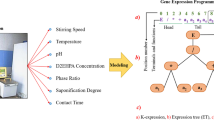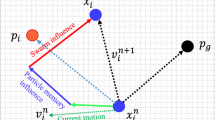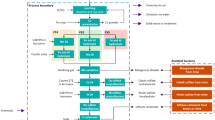Abstract
Modeling of leaching process as a function of operational variables can specify an accurate perspective in the forecasting of valuable metals’ recovery from waste lithium-ion batteries (LIBs). Gene-expression programming algorithm (GEP), an innovative progressed computing strategy, was utilized to estimate the recovery efficiency of manganese from waste LIBs. Numerous tests were performed through different leaching parameters, i.e., the concentration of reagents (Cr: H2SO4 and H2O2), the solid/liquid ratio (ρS/L), temperature (Tr), and experiment time (τr) as inputs and the manganese recovery as the corresponding GEP model output. The capability of the GEP model to anticipate and formulate leaching reaction was compared with response surface modeling (RSM). Results showed that the GEP model with mean R2 and MSE (mean square error) values of 0.982 and 0.01 is more accurate in manganese leaching prediction. The approach proposes a mathematical expression to describe the complicated relationship between the manganese recovery and the reaction parameters accurately. Furthermore, sensitivity analysis revealed that the solid/liquid ratio (ρS/L) and the leaching time were the foremost affecting variables on the manganese recovery.












Similar content being viewed by others
References
Eckhouse B, Pogkas D, Chediak M (2018) How batteries went from primitive power to global domination. In: Bloomberg. https://www.bloomberg.com/news/articles/2018-06-13/how-batteries-went-from-primitive-power-to-global-domination. Accessed 13 June 2018
(2020) Lithium-ion battery market worth $129 billion by 2027—breakdown by component, end-use industry and region—ResearchAndMarkets.com. In: Bus. WIRE. https://www.businesswire.com/news/home/20200720005363/en/Lithium-ion-Battery-Market-Worth-129-Billion-by-2027---Breakdown-by-Component-End-use-Industry-and-Region---ResearchAndMarkets.com. Accessed 20 July 2020
Willuhn M (2020) Battery manufacturing capacity set to increase fourfold to 1.3 TWh by 2030. https://www.pv-magazine.com/2020/08/12/battery-manufacturing-capacity-set-to-increase-fourfold-to-1-3-twh-by-2030/. Accessed 12 Aug 2020
Wang X, Gaustad G, Babbitt CW et al (2014) Economic and environmental characterization of an evolving Li-ion battery waste stream. J Environ Manag 135:126–134
Dorella G, Mansur MB (2007) A study of the separation of cobalt from spent Li-ion battery residues. J Power Sources 170:210–215. https://doi.org/10.1016/j.jpowsour.2007.04.025
Pant D, Dolker T (2017) Green and facile method for the recovery of spent lithium nickel manganese cobalt oxide (NMC) based Lithium ion batteries. Waste Manag 60:689–695. https://doi.org/10.1016/j.wasman.2016.09.039
Wang W-Y, Yen CH, Lin J-L, Xu R-B (2019) Recovery of high-purity metallic cobalt from lithium nickel manganese cobalt oxide (NMC)-type Li-ion battery. J Mater Cycles Waste Manag 21:300–307
Zhang X, Xie Y, Lin X et al (2013) An overview on the processes and technologies for recycling cathodic active materials from spent lithium-ion batteries. J Mater Cycles Waste Manag 15:420–430
Peters E (1991) The mathematical modeling of leaching systems. JOM 43:20–26
Menon A, Ren F, Wang J-Y, Giannis A (2016) Effect of pretreatment techniques on food waste solubilization and biogas production during thermophilic batch anaerobic digestion. J Mater Cycles Waste Manag 18:222–230
Nezhad HB, Miri M, Ghasemi MR (2019) New neural network-based response surface method for reliability analysis of structures. Neural Comput Appl 31:777–791
Cheng Q, Chirdon WM, Lin M et al (2019) Characterization, modeling, and optimization of a single-step process for leaching metallic ions from LiNi1/3Co1/3Mn1/3O2 cathodes for the recycling of spent lithium-ion batteries. Hydrometallurgy 185:1–11
Ferreira C (2005) Gene expression programming and the evolution of computer programs. Recent developments in biologically inspired computing. Igi Global, pp 82–103
Koza JR (1994) Genetic programming as a means for programming computers by natural selection. Stat Comput 4:87–112
Nazari A (2012) Experimental study and computer-aided prediction of percentage of water absorption of geopolymers produced by waste fly ash and rice husk bark ash. Int J Miner Process 110–111:74–81. https://doi.org/10.1016/j.minpro.2012.04.007
Antoniou M, Georgopoulos E, Theofilatos K et al (2010) A gene expression programming environment for fatigue modeling of composite materials. In: Konstantopoulos S, Perantonis S, Karkaletsis V, Spyropoulos CD, Vouros G (eds) Artificial intelligence: theories, models and applications, vol 6040. Springer Berlin Heidelberg, pp 297–302
Theofilatos K, Dimitrakopoulos C, Antoniou M et al (2012) Efficient computational prediction and scoring of human protein-protein interactions using a novel gene expression programming methodology. In: Jayne C, Yue S, Iliadis L (eds) Engineering Applications of Neural Networks—EANN 2012. Communications in computer and information science, vol 311. Springer Berlin Heidelberg, pp 472–481
Ebtehaj I, Bonakdari H, Hossein A et al (2015) Gene expression programming to predict the discharge coefficient in rectangular side weirs. Appl Soft Comput J 35:618–628. https://doi.org/10.1016/j.asoc.2015.07.003
Nazari A (2019) Application of gene expression programming to predict the compressive damage of lightweight aluminosilicate geopolymer. Neural Comput Appl 31:767–776. https://doi.org/10.1007/s00521-012-1137-5
Patil-Shinde V, Mulani KB, Donde K et al (2016) The removal of arsenite [As (III)] and arsenate [As (V)] ions from wastewater using TFA and TAFA resins: computational intelligence based reaction modeling and optimization. J Environ Chem Eng 4:4275–4286
Zhang L, Wang L, Hinds G et al (2014) Multi-objective optimization of lithium-ion battery model using genetic algorithm approach. J Power Sources 270:367–378. https://doi.org/10.1016/j.jpowsour.2014.07.110
Sobouti A, Rezai B, Rayati MT, Sadat F (2019) The recovery prediction of Zn and Pb from cerussite leaching using the fluoroboric acid by gene expression programming. Sep Sci Technol 00:1–9. https://doi.org/10.1080/01496395.2019.1708116
Garg A, Lam JSL (2015) Improving environmental sustainability by formulation of generalized power consumption models using an ensemble based multi-gene genetic programming approach. J Clean Prod 102:246–263
Mansouri I, Chacón R, Hu JW (2017) Improved predictive model to the cross-sectional resistance of CFT. J Mech Sci Technol 31:3887–3895
Ebrahimzade H, Khayati GR, Schaffie M (2018) A novel predictive model for estimation of cobalt leaching from waste Li-ion batteries: application of genetic programming for design. J Environ Chem Eng 6:3999–4007
Vishvakarma S, Dhawan N (2019) Recovery of cobalt and lithium values from discarded Li-ion batteries. J Sustain Metall 5:204–209
Jha MK, Kumari A, Jha AK et al (2013) Recovery of lithium and cobalt from waste lithium ion batteries of mobile phone. Waste Manag 33:1890–1897. https://doi.org/10.1016/j.wasman.2013.05.008
Ferreira C (2002) Gene expression programming in problem solving. Soft computing and industry. Springer, pp 635–653
Ferreira C (2006) Gene expression programming: mathematical modeling by an artificial intelligence. Springer
Ferreira C (2002) Genetic representation and genetic neutrality in gene expression programming. Adv Complex Syst 5:389–408
Peng Y, Yuan C, Qin X et al (2014) An improved gene expression programming approach for symbolic regression problems. Neurocomputing 137:293–301
Zhong J, Feng L, Ong Y-S (2017) Gene expression programming: a survey. IEEE Comput Intell Mag 12:54–72
Joo S, Shin D, Oh C et al (2016) Selective extraction of nickel from cobalt, manganese and lithium in pretreated leach liquors of ternary cathode material of spent lithium-ion batteries using synergism caused by Versatic 10 acid and LIX 84-I. Hydrometallurgy 159:65–74. https://doi.org/10.1016/j.hydromet.2015.10.012
Sarıdemir M (2010) Genetic programming approach for prediction of compressive strength of concretes containing rice husk ash. Constr Build Mater 24:1911–1919
Bajestani MI, Mousavi SM, Shojaosadati SA (2014) Bioleaching of heavy metals from spent household batteries using Acidithiobacillus ferrooxidans: statistical evaluation and optimization. Sep Purif Technol 132:309–316
Ebrahimzade H, Khayati GR, Schaffie M (2018) Leaching kinetics of valuable metals from waste Li-ion batteries using neural network approach. J Mater Cycles Waste Manag 20:2117–2129
Sivamani S, Selvakumar S, Rajendran K, Muthusamy S (2019) Artificial neural network–genetic algorithm-based optimization of biodiesel production from Simarouba glauca. Biofuels 10:393–401
Grenman H, Salmi T, Murzin DY (2011) Solid-liquid reaction kinetics—experimental aspects and model development. Rev Chem Eng 27:53–77. https://doi.org/10.1515/REVCE.2011.500
Libraries T (2017) Sustainable recovery of cathode materials from spent lithium-ion batteries using lactic acid leaching system. ACS Sustain Chem Eng 5:5224–5233
He LP, Sun SY, Song XF, Yu JG (2017) Leaching process for recovering valuable metals from the LiNi1/3Co1/3Mn1/3O2 cathode of lithium-ion batteries. Waste Manag 64:171–181. https://doi.org/10.1016/j.wasman.2017.02.011
Li L, Bian Y, Zhang X et al (2018) Process for recycling mixed-cathode materials from spent lithium-ion batteries and kinetics of leaching. Waste Manag 71:362–371. https://doi.org/10.1016/j.wasman.2017.10.028
Li J, Li X, Hu Q et al (2009) Study of extraction and purification of Ni, Co and Mn from spent battery material. Hydrometallurgy 99:7–12
Author information
Authors and Affiliations
Corresponding author
Additional information
Publisher's Note
Springer Nature remains neutral with regard to jurisdictional claims in published maps and institutional affiliations.
Rights and permissions
About this article
Cite this article
Ebrahimzade, H., Khayati, G.R. & Schaffie, M. Modeling of manganese recovery from waste Li-ion batteries by gene expression programming. J Mater Cycles Waste Manag 23, 2218–2231 (2021). https://doi.org/10.1007/s10163-021-01285-6
Received:
Accepted:
Published:
Issue Date:
DOI: https://doi.org/10.1007/s10163-021-01285-6




